The Google Pixel 2 Review: The best smartphone experience?
The Google Pixel 2, in "Clearly White".
Most online reviews of phones these days involve tech journalists reviewing phones for short periods of time, before they move on to the next phone. On the other hand, for most people who actually buy phones, we'll probably be using the phones on average between 1 to 3 years before we switch phones.
The experience over the long term is very important, not just the most flashy specifications or the "newest looks".
We bought the Google Pixel 2 for ourselves to use as the only phone for at least 2 years. So we'll be reviewing this phone as ordinary people, looking out for what ordinary people need in a smart phone.
That being said, at least one out of the two of us are geeks, so don't mind us if we still do gush over the flashy specifications. If you aren't interested in a comprehensive or technical overview of the phone, you can skip right to Design, Camera Performance and Parting Thoughts - and ignore any paragraphs that don't interest you.
The Google Pixel 2 - if you look closely you'll see its always-on display.
Specifications
- Display: 5.0" AMOLED, 1,080 x 1,920px resolution (441 pixels per inch),
supposed to cover 95% of the DCI-P3 colour gamut,
2.5D Corning Gorilla Glass 5,
Always-on/Ambient display, - Rear camera: 12.2 megapixels,
1/2.6" sized sensor (1.4µm pixel size),
f/1.8 aperture,
phase detection autofocus + laser autofocus,
HDR+,
dual LED flash,
optical image stabilisation - Front (selfie) camera: 8 megapixels,
1/3.2" sized sensor (1.4µm pixel size),
f/2.4 aperture - CPU & GPU: Qualcomm Snapdragon 835 (4x Kryo 280 Performance @ 2.35GHz, 4x Kryo 280 Efficiency @ 1.90GHz, Adreno 540),
Intel-designed "Pixel Visual Core" image processor (1x Cortex A53 CPU, 8x IPU cores) - RAM: 4GB LPDDR4x
- Dimensions: 145.7 x 69.7 x 7.8 mm, 143g
- Battery capacity: 2700 mAh (10.39 Wh)
- SIM size: nano SIM (also supports eSIM)
- Wireless: 802.11a/b/g/n/ac 2x2 MU-MIMO,
WiFi-Direct,
Bluetooth 5.0 LE (supports A2DP and aptx HD),
NFC,
GPS/GNSS/Beidou/Galileo,
Qualcomm X16 LTE modem - supports 2G / 3G / 4G LTE (world-wide mobile compatibility, supports up to CAT 15 LTE) - Connectivity: USB 3.1 Type-C,
No 3.5mm headphone jack - OS at launch: Android 8.0 Oreo (updates directly with Google)
- Storage: 64GB / 128GB (ours was 128GB)
- Materials: Aluminium unibody with "hybrid" plastic coating
- Waterproofing: IP67 water and dust resistance (fully protected from dust, can withstand submersion in 1m of water up to 30 mins)
- Miscellaneous features: Fingerprint scanner on the rear,
"Active Edge" (squeeze phone to activate Google Assistant),
dual front-facing speakers
Introduction
Google has always been a web-advertising company at its core - it made its fortunes starting out as a search engine, and a substantial amount of its revenue comes from online advertising.
This also means that Google has little history as a hardware manufacturer. This is important for this review because, while the Google Pixel 2 is branded as "The phone only Google could make", the phone is in fact manufactured by HTC.
Hardware manufacturing might not be Google's forte, but the Google Pixel 2 has simple, good looks.
“Google’s use of machine-learning algorithms tangibly improve the Pixel 2, particularly with the camera.”
But where the magic happens is in the software. Google has marketed the phone using buzzwords like "machine-learning", "artificial intelligence" and "algorithms". Happily though, these buzzwords actually mean something. Unlike Huawei's unproven promises in their "Neural Processing Unit" for "On-Device AI", Google's use of machine-learning algorithms tangibly improve the Pixel 2, particularly with the camera.
We explain more in the rest of this review.
Design
The Google Pixel 2 has a modern, almost Scandinavian design aesthetic. We got the "Clearly White" Google Pixel 2 model, which has a white back and sides, matte silver buttons on the right hand side and a black front.
The Google Pixel 2 has a glass "window" on top.
The main standout design feature is its aluminium unibody that's coated with what Google is calling a "hybrid coating". A scratch-down test has shown that this "hybrid coating" is actually just plastic paint on top of the aluminium body.
This plastic-coated aluminium body covers about 70% of the back of the phone and wraps around its sides. The plastic coating actually feels nice in hand, almost like eggshells (though, of course, it's very solid eggshells that don't crack as easily as eggs). It's matte but isn't rough, with a gently textured surface. Put simply, it looks great and feels great, though it probably isn't quite so scratch-resistant.
The remaining 30% of the back is covered in glass. Glass is more transparent to radio frequencies than metal. So the glass "window" is probably meant to provide better performance for the phone antennas (and, correspondingly, reception).
“It looks nice and distinctive, though not overtly so. If you look out for it, you can tell it’s special ...”
The mix of the metal and glass on the back of the phone has somewhat become a Google Pixel trademark. The glass window is in a "darker" shade of "white" (read: it's actually a really light grey) and it's a nice juxtaposition against the snow-white matte "metal". It looks nice and distinctive, though not overtly so. If you look out for it, you can tell it's special, but if you don't, it still doesn't stick out like a sore thumb.
The power button (left) and volume buttons (right) are on the right side of the phone.
The front of the phone is more unexceptional. It features a screen that has a 127 mm (5.0 inch) diagonal length (with a length and width of about 111.5 mm x 60.8 mm). The dimensions of the phone are 145.7 mm x 69.7 mm, so this means the rest of the front are, well, bezels.
A lot has been said in countless online reviews about how the phone looks terrible because of the "large" bezels. What's interesting, though, is just a year ago these "large" bezels were perfectly normal (except on Samsung's "edge" phones). Also, these bezels give you room to actually hold on to the phone and use it without accidentally pressing the sides of the screen. In that way, it's not a bad thing.
The bezels actually don't bother us at all. They make the phone a little larger in comparison to the relatively small screen (by today's standards, at least), but the screen is big enough for everything the phone's used for - YouTube, web browsing, whatever apps we use. It doesn't bother us at all and the phone still looks great.
Yes, the Google Pixel 2 has "thick" bezels. No, it doesn't bother us at all.
Hardware
The Google Pixel 2 has top of the line specs for Android phones in 2017, which isn't to say much. You can see more in Specifications above. Most ordinary users don't really care about the specifications of the phone, so long as it works well.
Many don't realise that Apple actually uses processors (both the CPU and GPU) on their iPhones that are leaps and bounds ahead of the Android competition. But it doesn't matter if it doesn't actually work better. So in this review, we'll focus on the actual performance, rather than the specifications.
Something to take note of about the Pixel 2 is that it uses USB-C and not regular micro USB that is used on older phones. The phone comes with a USB-C cable for charging, but it can only be used with a USB-C charger. If you want to hook up the Google Pixel 2 to your laptop/desktop that only has USB-A (but no USB-C), you'll need to buy your own USB-A to USB-C cable.
The Google Pixel 2 has a single USB-C port at the bottom. No 3.5mm headphone jack!
The Google Pixel 2 has a fingerprint sensor on the rear, which isn't all that out-of-the-ordinary for an Android phone. But this fingerprint sensor is lightning fast. One tap of our finger and BOOM the phone's unlocked. It even works reasonably well (though not 100% of the time) when our finger is wet. It's definitely faster and better at recognising our fingers than my Samsung Galaxy S7 edge.
The Google Pixel 2 also features dual front-facing speakers. A lot has been said online about them, although to us they remain unexceptional. These speakers can go louder than other flagship phones with less distortion. But, as with all phone speakers, they're far from amazing for watching movies or listening to music. Perhaps their advantage is that it's easier to listen to the sounds while watching YouTube (without having to cup the bottom-firing speakers, like on other phones).
There are 2 hardware disappointments, though. First, there's no 3.5mm headphone jack. The phone comes with a USB-C to 3.5mm jack dongle (which includes a DAC). But this is a hassle - you'll have to bring an extra dongle around with you, and you can't charge your phone at the same time. Second, there's no expandable storage using a micro-SD card. You're limited to either the 64GB or 128GB in whichever phone you choose.
“Google actually has hidden technology ... that’s largely unique to the Pixels ... there’s the “Pixel Visual Core” ... [and] ... the “Active Edge” feature.”
What's notable in the Google Pixel 2 is that Google actually has hidden technology inside the Google Pixel 2 that's largely unique to the Pixels (for now, at least).
First, there's the "Pixel Visual Core", which is essentially an entire system-on-chip (kind of like a mini computer), used specifically for processing camera shots. At this point of time, it's unclear exactly to what extent it's in use (a future update will apparently allow third party apps to use the Pixel Visual Core to improve photos taken by those apps).
What's clear is that the results are amazing. You'll see more in our section on Camera Performance below.
"Active Edge" allows you to squeeze the Pixel 2 to activate Google Assistant.
Second, though less unique, is the "Active Edge" feature. Remember how the Google Pixel 2 is actually manufactured by HTC? Well, HTC designed a "squeeze" feature in their HTC U11 phone this year, and the same feature made it to Google's Pixel 2. How it works is simply by squeezing the phone, and Google Assistant is activated.
Once Google Assistant is activated, you can use your voice to control it. You can use it for a very wide range of functions. Google's examples include telling the phone to take a selfie - Google then opens the camera app and takes a selfie. We've used it, and it works well.
Because we have a smart home, we can use Google Assistant to control our smart home too. We can squeeze the phone and say turn on the bedroom lights, and the bedroom lights will turn on. Or we could squeeze the phone and say, "Broadcast I'm on my way home", and our Google Home in the living room will announce "I'm on my way home", in our voice. This works better than sending a text or having to make a phone call.
It's just brilliance in software. And we're still only in the Hardware section of the review.
Display
The display is about 111.5 mm x 60.8 mm, with a 5.0 inch / 127 mm diagonal. Its resolution is full HD - 1,920 x 1,080 pixels. Google states that the display should cover 95% of the DCI-P3 colour gamut. We don't have a colorimeter or spectrophotometer (because we're not professionals) to test the colour accuracy or the brightness/contrast statistics.
Based on what we've seen online, it appears that when the Google Pixel 2 is placed in non-vivid mode in the display settings, it's accurate to sRGB. It's unclear if the display itself is factory calibrated. We'll have to wait for the AnandTech review for that.
The Google Pixel 2 display looks good, and is "accurate".
What does this all mean for us? Not much at all if you're just using your phone to browse the web.
But if you take photos with the camera and share it online, you'll want a display that's more or less colour-accurate. Otherwise, you might end up with photos that look great on your phone only. And look horribly neon green/neon red/washed out/whatever on everyone else's screen.
“Your photos and images should look “correct” on the Pixel 2 screen, and on other screens too ... The screen performs excellently in general.”
Because the version of Android on the Google Pixel 2 (Android 8.0 Oreo as of the time of writing this) has colour management, and because the display is more or less accurate to established colour spaces (sRGB and DCI-P3), you don't have to worry too much about that. Your photos and images should look "correct" on the Pixel 2 screen, and on other screens too, unless those other screens themselves are horribly inaccurate.
The screen performs excellently in general. It has wide viewing angles, so even if your face isn't perpendicular to the screen, it still looks good. Because of the high pixel-density (441 pixels per inch), when you're using the Pixel 2, the display won't look grainy or low-res.
The use of an OLED screen on the Google Pixel 2 also means that you'll have great contrast ratios - the videos you watch and images you see won't feel washed out.
We note that out of the box, the screen has an oleophobic coating that works well. This means fingerprints don't really adhere to the screen easily and, if they do, it's easy to use any cloth to remove them. Also, water doesn't "stick" to the screen. It's wonderful. But oleophobic coatings on screens wear out over time, so we'll have to see how this weathers the test of time.
Software Performance
This is a big deal to us. If you've ever used a phone that was blitzed along and was smooth as butter at the beginning, but slowed down with weeks and months, you'll understand how we feel about it.
To a certain extent this plagues Android users more than iOS/iPhone users, though your mileage may vary. Based on our own experience, it seems that with our Samsung Galaxy S6/S7 Edge phones, they were really quick at first, but became considerably more stuttery and laggy with time.
The Google Pixel 2 home screen. "Live" wallpapers, with subtle animations in the background, are enabled by default.
For iPhones in general, what we've observed was that the phones are very smooth for a while, maybe a year. But when new iOS updates come, they gain a bit of a slowdown. The UI still feels smooth, but things load slower. Then in the second year, with another iOS update, the phone becomes painfully slow and stuttery too.
What does this mean for the average user? It means we want phones that work well, not just during the "honeymoon" phase, but throughout the period of time we use the phone.
Generic CPU and GPU benchmarks are almost worthless in this respect. You could get a phone with stunning numbers on the benchmarks, but are still a slow and stuttery mess. Why? Because most flagship Android phones in a particular year have more or less the same processors, the benchmarks simply measure how well the software is optimised for that benchmark, but not for the general user's experience.
“it’s mostly bug-free and oh-so-fast. The UI is smooth - you won’t have any annoying dropped frames or stutters. Also, apps load quickly, the camera opens lightning fast ... and websites parse nearly instantly ...”
With that out of the way, how does the Google Pixel 2 perform?
We're happy to report: it's mostly bug-free and oh-so-fast. The UI is smooth - you won't have any annoying dropped frames or stutters. Also, apps load quickly, the camera opens lightning fast (when you double tap the power button or click on the app), and websites parse nearly instantly (subject to a quick internet connection).
In fact, the websites run very smoothly - including our index page, which doesn't move quite as fluidly on my Samsung Galaxy s7 edge as the Google Pixel 2.
Of course, we've only used the phone for just over 2 weeks. But based on online reports, phones using software optimised by Google for that phone (like last year's Google Pixel and the Nexus 6P before that) generally remain smooth and fast through their lifespan. We'll keep this space updated over long term usage.
There are some minor bugs, but we have full faith that these should be resolved with a software update soon enough. We've found that sometimes (we haven't been able to reproduce the problem and find the trigger) the ambient display goes a bit gray instead of black. Also, some apps have crashed and caused the phone to freeze before.
These bugs aren't common and don't happen frequently - not enough to negatively mar our impression of the phone compared to other phones we've used. We'll update this space on what happens in future updates.
Optimised software also means better battery life thanks to efficiency. Even though the battery capacity of the Google Pixel 2 is relatively low at 2700 mAh, its battery endurance is very long. With normal usage for us, the phone's battery easily lasts the entire day, with about 20-30% of battery to spare.
This is a subjective measurement. But to give you an idea of how we use the phone - we don't usually set the brightness of the phone very high - just bright enough to see the screen under all lighting. We use the phone for social media, text messaging, emails, web browsing and many, many photos. And it's easily able to give more than 6 hours of "screen on" time, and last through the whole day.
Special Software Features
We explained in our Introduction that this phone was all about software smarts. And the software is smart.
Google Assistant
Google Assistant isn't something that's new, and technically it's readily available on all Android phones. Still, it's a noteworthy feature to point out because of just how useful it is.
Squeeze the phone, or say "Ok Google" or "Hey Google", to summon Google Assistant.
Google Assistant is like a responsive Google search robot, or a cleverer version of iOS's Siri. You can ask it questions, from recipes to trivia to unit conversions, and it'll helpfully provide what it thinks is the answer. More often than not the answer is correct, though sometimes it gets things wrong or misunderstands your question.
“... it’s a noteworthy feature to point out because of just how useful it is.”
Google Assistant can also help create calendar entries based on what's on your screen. Google Assistant can even control your smart home devices if they're compatible with and set up in the Google Home app.
In our case, we do have our smart home devices set up - so Google Assistant allows us to easily control the lights, blinds, air-conditioning and music in our home. Google Assistant also allows us to "broadcast" messages to our Google Home speaker - sort of like an announcement through the intercom.
And Google Assistant is easy to activate in the Google Pixel 2. There's an always on speaker that only listens out for the hot words "Hey Google" or "Ok, Google" to activate it. Or you could just squeeze the Google Pixel 2.
Active Edge
Speaking of squeezing the Google Pixel 2, Google Assistant can also be activated without saying "Ok, Google". When the phone is set up, you calibrate how hard you want to squeeze the phone to activate Google Assistant (if at all), and you're ready.
Just squeeze the phone and tell Google what you need to get done. Unlike HTC's original implementation of the squeeze feature, you can't customise what the squeeze does.
It's still useful - you can squeeze and just say turn on wifi; or squeeze and just say take a photo.
Now Playing
Thanks to that always-on microphone that listens out for Google's hot words (but doesn't record nor upload anything to the Internet), the phone can also listen to music in the background.
The "Now Playing" feature shows you what song is playing at the moment on the always-on display.
The Google Pixel 2 has an internal database stored on the phone of about 15,000 songs that Google thinks is mostly being listened to in your region. After about 10-30 seconds of listening to that music, the Google Pixel 2 will tell you what song is playing in the background on the always on display.
It's really cool. And it helps that none of what's recorded gets uploaded into the Internet. So, you know, it's not quite so creepy. Also, this minimises battery drain, so the feature doesn't really take a toll on your overall battery life.
Always-On Display
Yes, by default the display is "always on". Google calls it the ambient display, because it's not always on to the lockscreen. Instead, it's always on to a minimal black screen which shows only the time, some icons for your most recent notifications and the "Now Playing" feature.
After you "lock" the phone, the lockscreen is always on - showing you the time, notification icons and what song is now playing.
This doesn't really drain your battery either because of the OLED screen. On OLED screens, the black portions are completely turned off, so only a small portion of the display is drawing power.
Google Photos
Google Photos comes pre-installed on the Google Pixel 2. Also, it allows you to upload all images from the Pixel 2 into Google's cloud storage at full resolution (without compression) for free, until 15 January 2021. After that, all photos already uploaded can remain, but new photos must be compressed for free storage.
This somewhat makes up for the lack of expandable storage we lamented in "Hardware" above. If you have good access to the Internet and sufficient data allowance, you can freely delete old photos from your Google Pixel 2, and they stay alive, full-res, in Google's cloud. So you can always go back there and find it.
There is an assistant in Google Photos, which is very smart - it brings up all sorts of suggestions and analyses your photos for you.
Speaking of storing images in the "cloud", yes, it does feel creepy. It doesn't help that Google analyses your images for you, beyond the metadata tags.
“... you can freely delete old photos ... and they stay alive, full-res, in Google’s cloud. ... Google photos also ... analyses the images ... [and] you can search for these in the Google Photos app, and it’ll find them for you.”
If you've used an iPhone's photos app or Samsung's gallery app before, you'll understand what we mean about the metadata tags. You can search for images based on location (if you turned on geo-location when taking photos) or time - these are hidden information stored in images themselves. The app just reads that data and sorts it out for you.
But Google does more than that. It also analyses the photos to see whose faces are inside, match them with other photos, and creates a face database. You can, if you choose to, give names to the faces then you can easily find photos with that person inside.
But Google photos also does even more. It also analyses the images for more common things - like shoes, hats, beards, cats, dogs etc. You can search for these in the Google Photos app, and it'll find them for you.
Useful, but wow it's stalker-ish.
Camera Performance
The Google Pixel 2 cameras are perhaps our highlight of the phone, other than the phone's software performance. This is actually ironic, because a large part of the brilliance of the camera is due to its software performance.
The camera launches very quickly - just open the camera app or double tap the power button and it speedily zooms onto your screen. There're few options to calibrate your images. Other than exposure and focus, there aren't many settings (like white balance) that you can change when taking photos.
The thing is, the Pixel 2's camera performs so well, you'll rarely miss the ability to change those settings.
This shot was taken on the Google Pixel 2 rear camera in low light - but is still sharp with accurate colours and minimal noise.
Unfortunately, we don't have ISO charts, resolution test charts or dioramas to objectively test the camera's performance. Nor do we have many phones or cameras with which to compare the performance of the Google Pixel 2's camera objectively.
However, we can say with confidence that the results from the Google Pixel 2's camera are astounding.
HDR - High Dynamic Range
First of all, it has HDR processing turned on by default. Once you open Google's camera app and take any photos, the camera is actually continually taking multiple (usually up to 10) photos at lower exposures. The software aggregates these photos together, uses machine-learning brilliance, determines the dynamic range of the shot, and creates a beautiful photo with high dynamic range.
“... the Pixel 2’s camera performs so well, ... photos have a high dynamic range and noise is also reduced .... ”
Photos with high dynamic range are simply more true to life - closer to the brightness and colours you see in real life. Most cameras (let alone phone cameras) have sensors that are too small to capture the full spectrum of visible light. So images end up looking dull.
This shot from the Google Pixel 2 shows good detail, low noise and accurate colours. The blurring on the left is from portrait mode.
With Google's HDR activated, photos have a high dynamic range and noise is also reduced in the images, and they're less grainy. This also means low light performance of the Google Pixel 2 is nothing short of awesome.
The icing on the cake is that HDR can be automatically enabled for all of these features, so the photos still come out looking great!
HDR mode combines data from many low exposure images into one photo giving a high dynamic range - in this photo taken on the Pixel 2 the very bright background is still clearly visible against the much lower light in Ikeda Spa. Everything is visible and not over or under exposed.
Google's HDR does all of that, automatically, with software.
Portrait Mode
Second, the Google Pixel 2 has what is probably the most effective "portrait mode". If you've used the iPhone 7 Plus, iPhone 8 Plus or iPhone X, you'll probably be aware of the wonders of fake bokeh in portrait mode. In this mode, the subject is clearly in focus while the background is a creamy blur, looking like something taken on a professional camera.
This particular shot on the Pixel 2 isn't well-composed, but you can see how portrait mode works well with food photos.
But if you've used portrait mode on an iPhone, you'll also know that the feature is very far from perfect. Often, parts of the subject that should be in focus are accidentally blurred, and vice versa. You'll notice this especially close to thin lines - for example, the area surrounding your subject's hair is usually very imperfectly blurred.
“... the subject is clearly in focus while the background is a creamy blur ... the results are seriously staggering ...”
Well, Google attempted to fix that with software. Rather than use 2 rear cameras for its portrait mode, Google used a sensor that's big enough to take photos with "dual pixels". Pixel pairs on the camera sensor capture the same portion of your image, but because they're very slightly apart, it's possible for the software to approximate the distance of each portion of the image from the phone (you know, using Pythagoras' Theorem).
Another food shot on the Google Pixel 2 with portrait mode enabled.
Then, using machine-learning algorithms, the Google Pixel 2 tries to guess what the actual subject of the photo is - for example, your friend's face and hair. With this information, it knows that your subject (your friend's face and hair in our example) should be in focus, and everything else that's in the distance is blurred.
Using this mixture of hardware and software, the results are seriously staggering, and definitely better than the portrait mode images we've seen from iPhones on Instagram.
Portrait mode isn't perfect, yet. You can see in this image that some portions (particularly metal bars on the left) are incorrectly blurred.
Still, there will be photos where the portrait mode got it wrong. In some images, certain parts of the background aren't blurred. In other images, if you zoom in, you'll see that some parts of the subject's hair has "halos" around it. It's largely still very effective, though.
A note on machine-learning in the Google Pixel 2's camera software: What is machine-learning? Put simply, it's an algorithm, or programme, that draws from real-world examples to understand how to perform its functions. For example, Google's machine-learning software for "portrait mode" was given real world examples of photos and told which parts of each photo should be in focus, and which part should be blurred. After studying many of these photos, the machine-learning software gets an idea of what it should do, and what it shouldn't do.
Google has advertised that it apparently "trained" its machine-learning photos with a million shots to teach it what should be blurred, and what shouldn't be blurred when taking photos. That's why it can work for the front-facing camera too, despite not having the "dual-pixel" technology to approximate the distance of the subject and background of the shot from the phone.
The upside to this is that you have amazing DSLR-like images and bokeh when using portrait mode for people's portraits and many macro objects.
However, the downside to a software implementation is that it's only as good as Google has trained it to be. So for certain objects in your photos, and even for certain clothing or hats, the blurring might still be imperfect. This is simply because the machine-learning algorithm hadn't been trained for that scenario.
As far as we've used the phone though, it's probably the best implementation of a portrait mode compared to all other smartphones available on the market at the moment (including the iPhone X).
Portrait mode on the Pixel 2 effectively blurred the background here, except that some portions of the bamboo leaves are less blurred.
Front-Facing Camera
What's more, the front facing camera has this portrait mode and automatic HDR enabled too. While the front facing camera does not have a sensor large enough for the "dual-pixel" technology, using the machine-learning algorithms mentioned above, the selfie portrait photos are also nothing short of amazing. If you don't zoom in, it's near impossible to tell that the photos are from a front-facing camera.
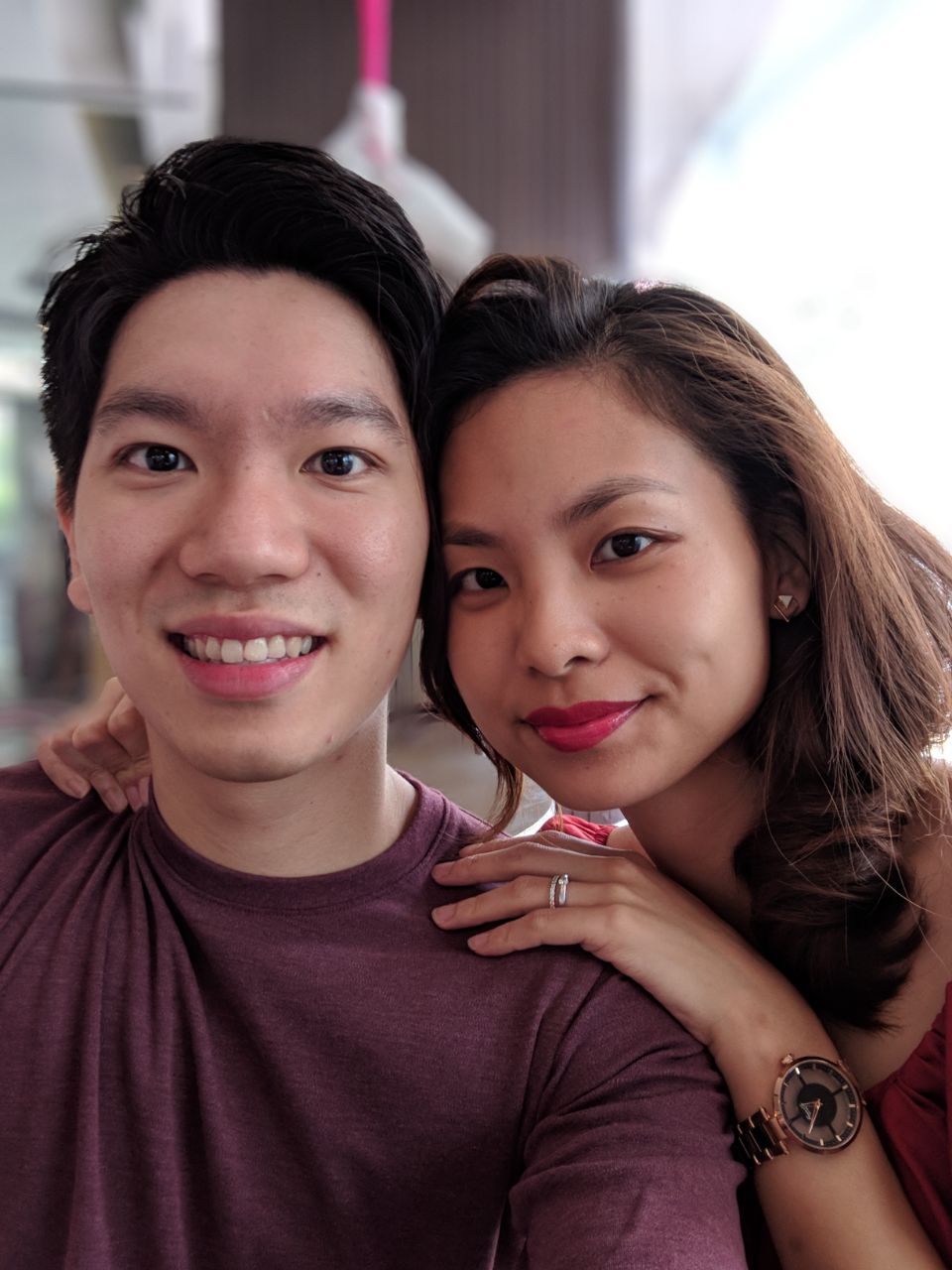
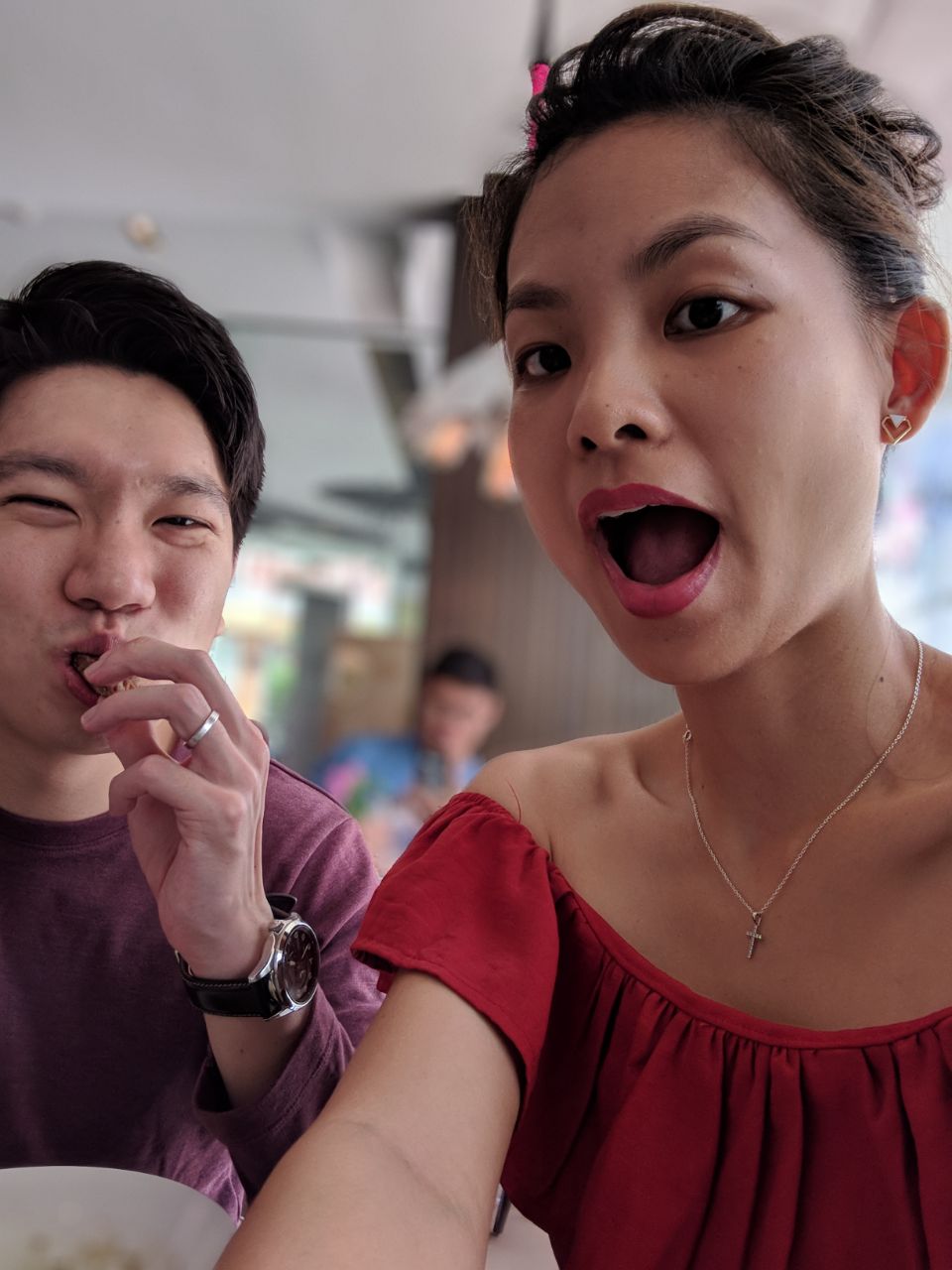
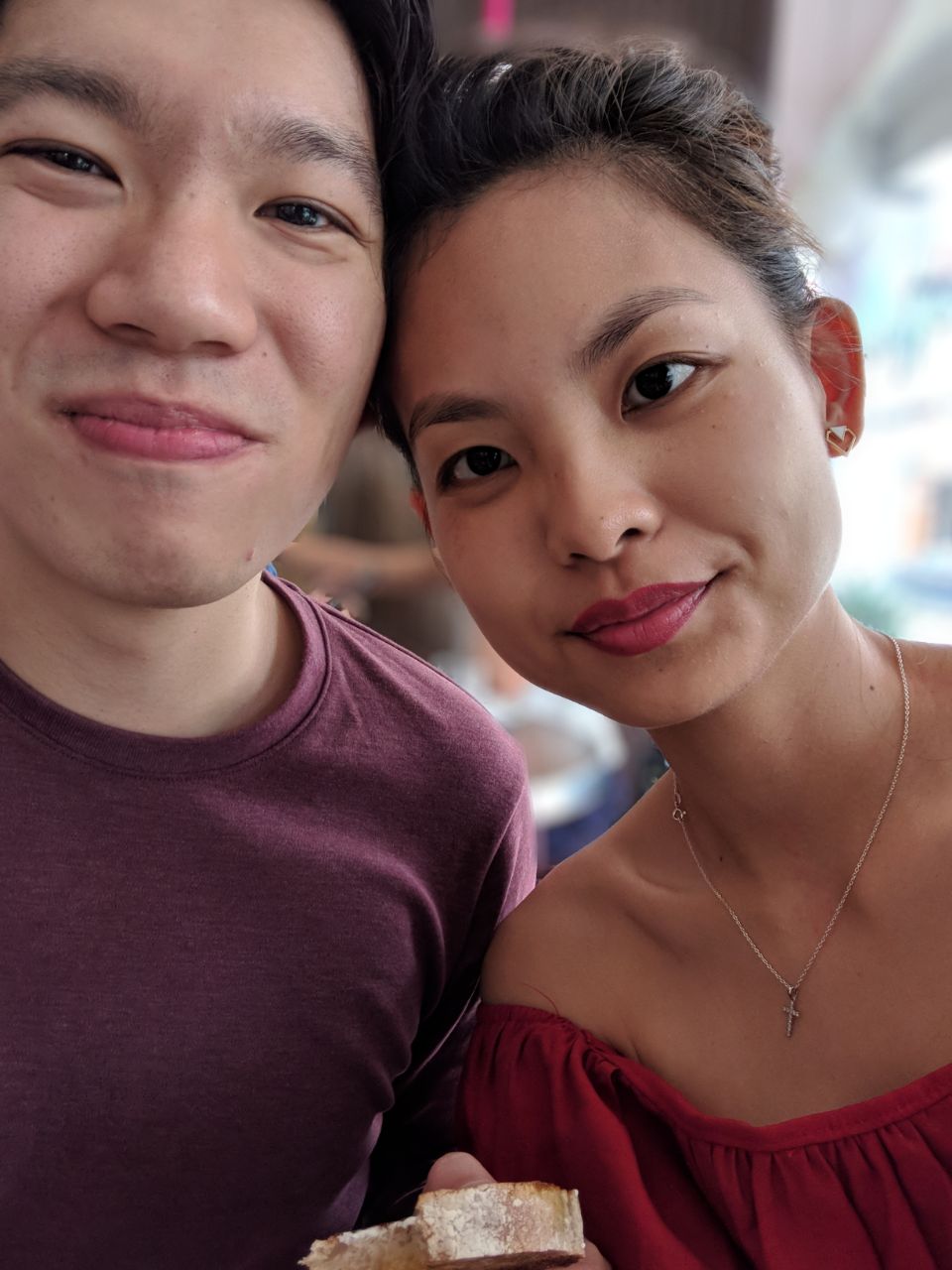
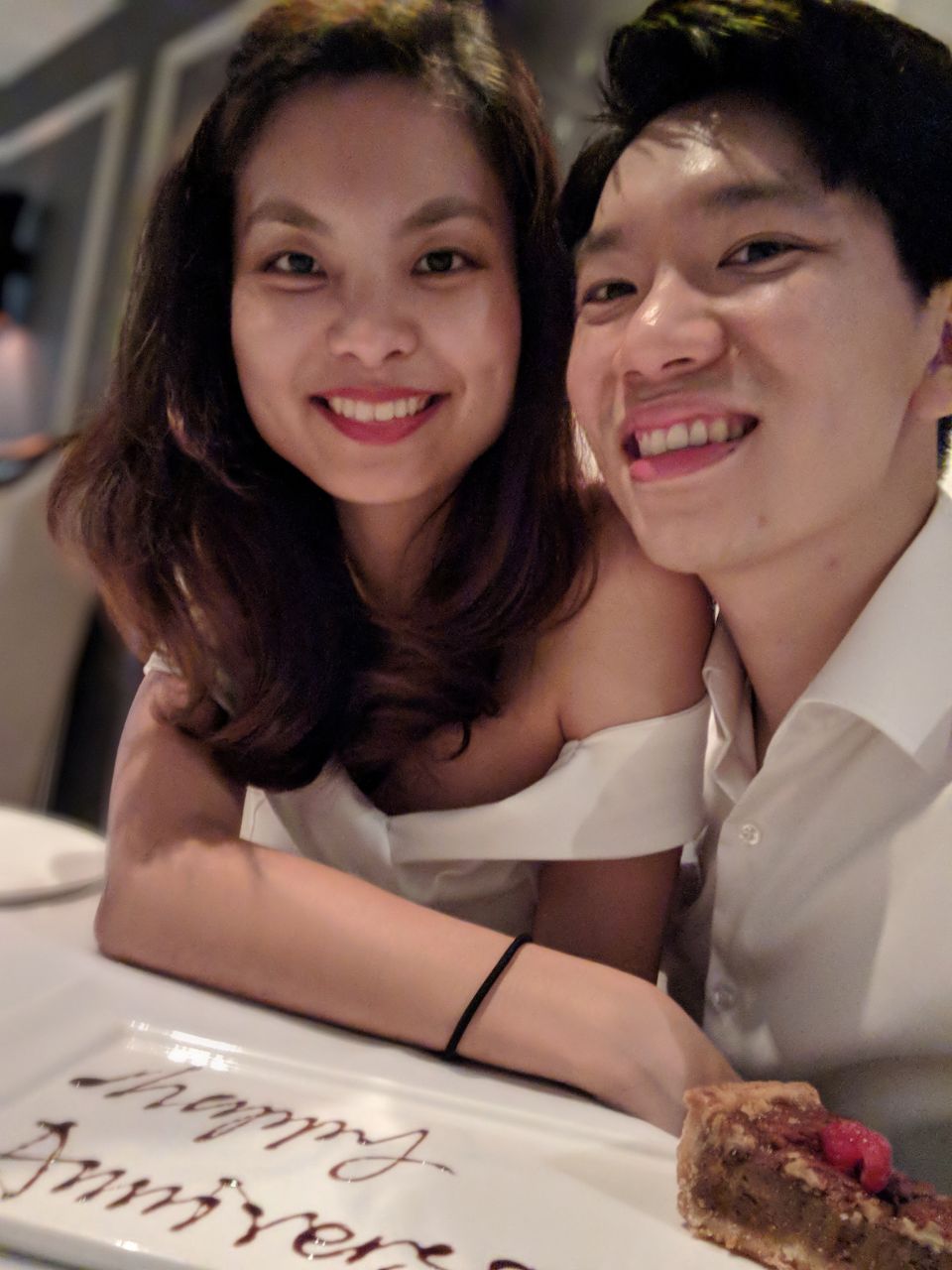

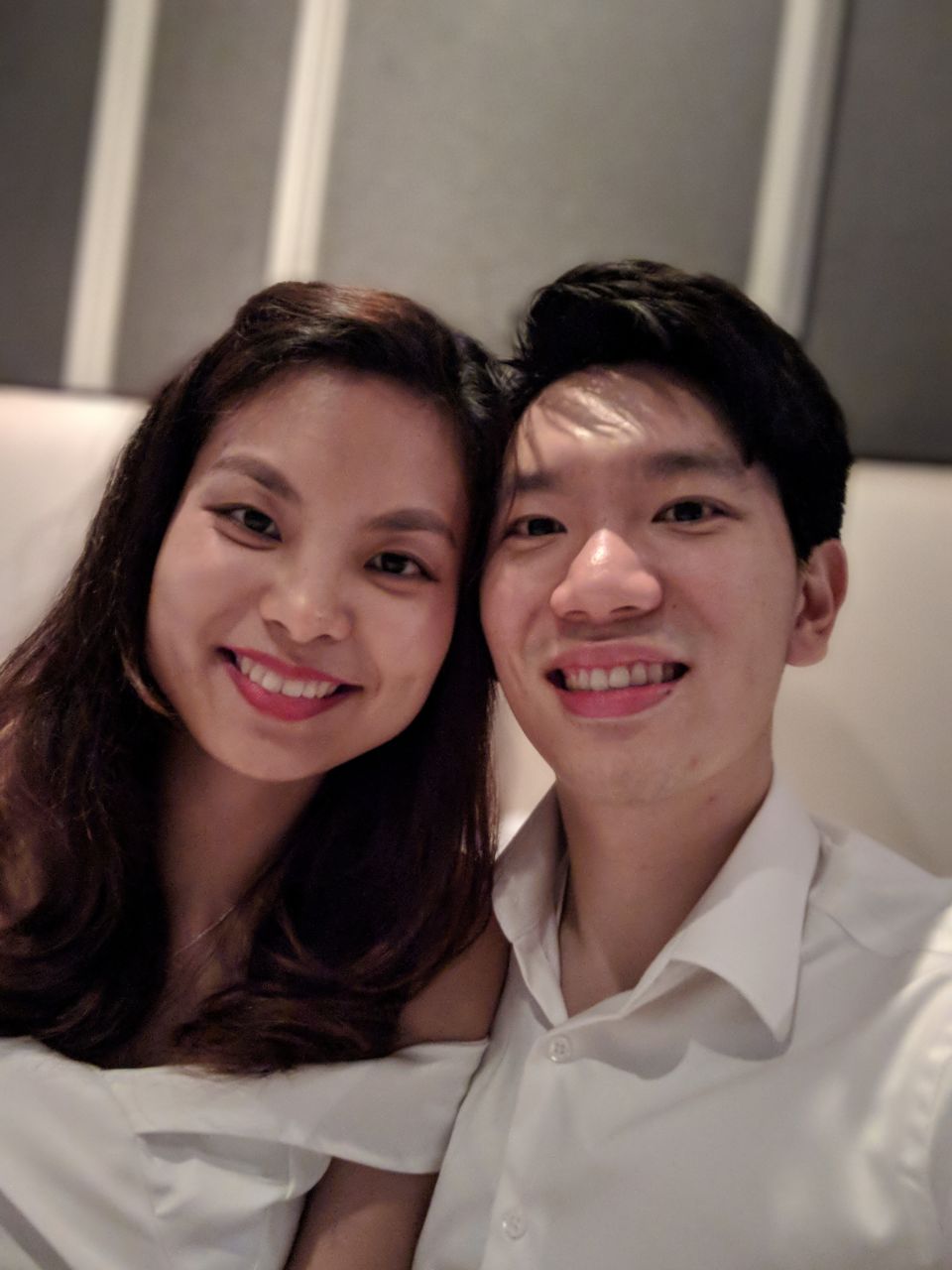
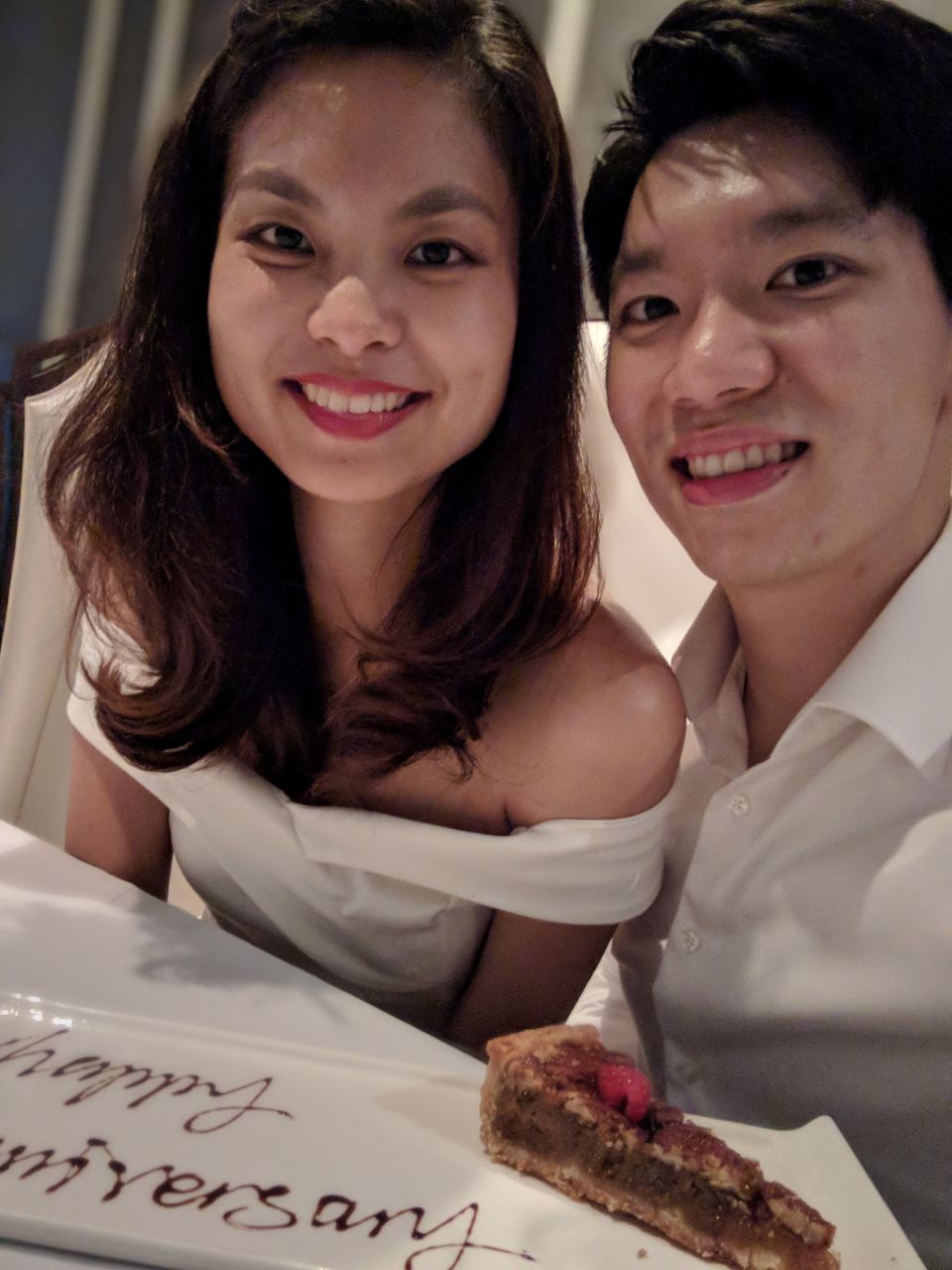
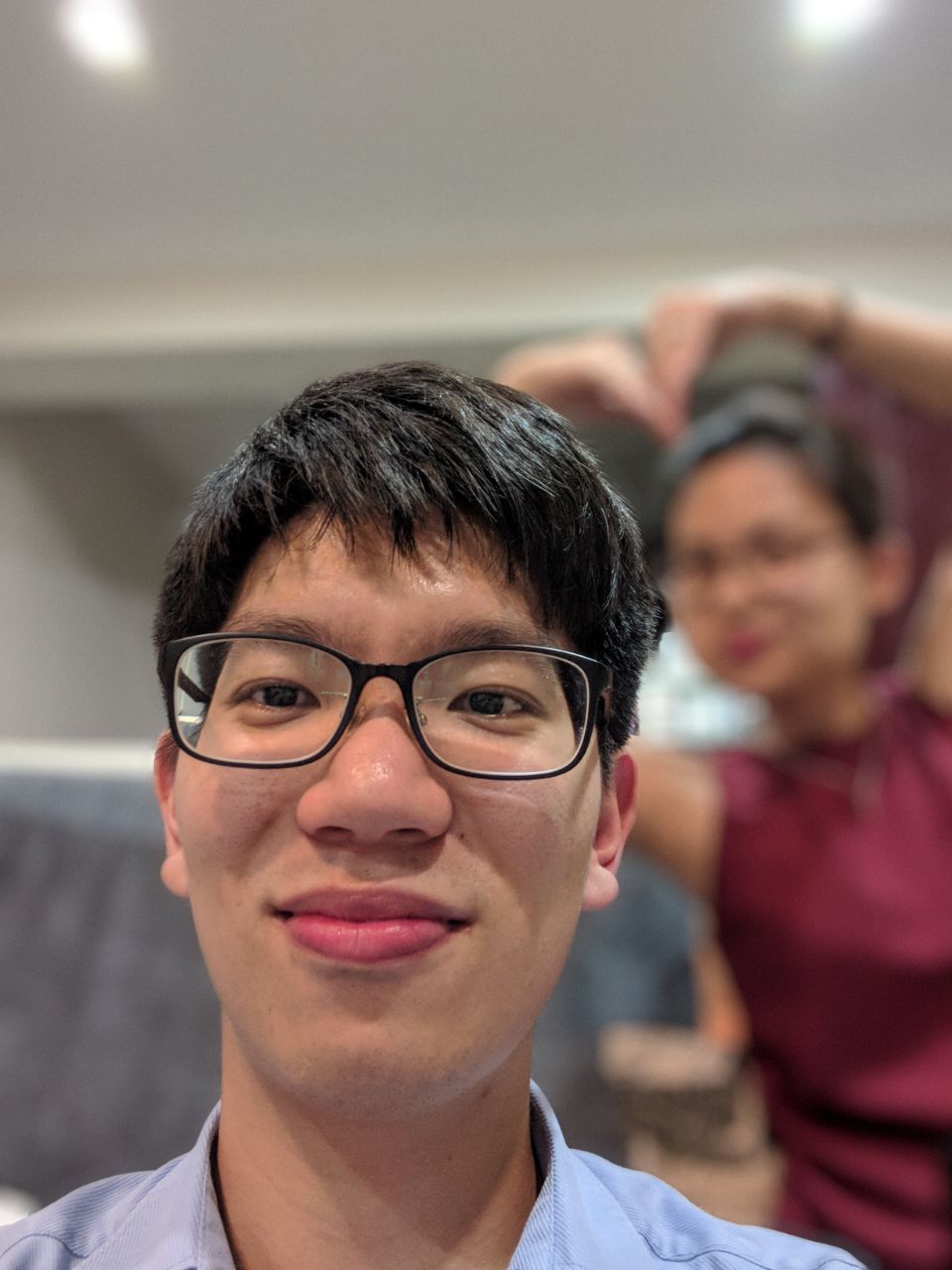
Motion Photos
Google also has what they call "motion photos", which is very similar to the iPhone's Live Photos. The motion photos on the Google Pixel 2 are enhanced over the iPhone implementation though.
A motion photo is essentially an animated photo - movement before and after a photo is shot is recorded at 29 frames per second, similar to a video. The difference between a video and a motion photo is that motion photos are automatically recorded when a photo is taken, if the setting is enabled.
A "motion photo" automatically taken from the Google Pixel 2 camera - saved as a GIF using Google's Motion Stills app.
You can set motion photos to "automatic", and the camera will take motion photos only when there actually is motion before or after the photo was taken, to save storage space.
Also, machine-learning algorithms help to guess when the motion is caused by the user shifting the Pixel 2 to take the photo, and eliminate those parts of the motion photos. What you're left with is an interesting motion photo that you might actually want to share with your friends - people moving in the shot in funny ways, sizzling food, moving water etc.
Video Performance
We haven't yet had an opportunity to properly test the video camera's performance. While we have taken videos with the Google Pixel 2, these were largely for memories-sake. This also means that we don't have any particularly enticing videos shot on the Pixel 2 to upload. Yet.
But from our use of the video camera on the Google Pixel 2, we can say that it performs well, just as its camera has.
There are also countless online reports about how effective the video stabilisation is as well. That is all true. So you could be walking and filming at the same time, and your video wouldn't be a shaky mess that causes every viewer to get a headache. This comes as a result of both OIS (optical image stabilisation) and EIS (electronic image stabilisation).
OIS is a well-known quantity at this point - the camera is situated on special mounts that stabilise it if the phone shakes. This helps prevent shakiness in both photos and videos.
EIS has already been implemented in other phones before. But Google's machine-learning software magic happens here as well, to a great degree. The video software has somehow been trained to interpret shakiness, and eliminated that by software. The software is so effective that even the "jelly effect" that's usually visible when EIS is applied is minimised.
“What you have then is a video that’s really stable ... for ordinary use ... the video performance is good enough.”
What you have then is a video that's really stable (considering the shakiness of the user). This still isn't perfect. But we own a gimbal, and that's what a gimbal is for - to remove shakiness when moving around. We'll provide a review of our gimbal and explain more at a later stage.
The video camera is able to shoot in 1080p resolution at 60 or 30 frames per second or 4K resolution at 30 frames per second. It's also able to shoot slow motion videos in 720p resolution at 240 frames per second or in 1080p resolution at 120 frames per second.
There is one well-known problem with the video camera though. Specifically, its mic. The microphone only records audio in mono, and the sound tends to be hollow and even feel muted.
But for ordinary use for social media and what not - the video performance is good enough and the stabilisation is wonderful.
Parting Thoughts
There are many other aspects of the Google Pixel 2 that we haven't delved into. There's the performance of its Wifi/Bluetooth/LTE modems, the quality of audio (whether or not through the USB DAC dongle), and more.
But that's not the point of this review. This review of the Google Pixel 2 looks at what matters most to us, as ordinary users of a smartphone these days.
The Google Pixel 2 is smart - just like our Amazon echo dot (to the left) and Google Home (to the right).
And we're very happy to say that it's been a happy purchase decision. The Google Pixel 2 simply excels where it counts. The software and user interface just run so smooth and loads so quickly. The camera gives the best photos for memories/keepsakes, uploading to social media and sending to friends. And the phone looks and feels nice.
What more could we ask for? It would have been better if it had a 3.5mm audio jack, and if the screen were bigger at the same physical size of the phone (considering the physical dimensions of the Google Pixel 2). But these are far from deal-breakers at this point.
To us, the Google Pixel 2 is the best smartphone experience you can get.
To us, it's clear that the Google Pixel 2 presents the best smartphone experience you can get today on Android. There's really nothing we can think of to "worry about" when getting this phone, perhaps other than accidentally dropping it.
In fact, the Google Pixel 2 performs so well for us that we would think it's the best smartphone experience, period. If you aren't tied into the iOS ecosystem, aren't desperate for the iPhone X's AR capabilities, and you're willing to learn how to navigate through a new user interface, we'd dare say the Google Pixel 2 is the best smartphone on the market today.
Do we enjoy the smart life with this? Need we say more? Of course we do.
Who should buy this? Anyone who wants to get a new Android smart phone. Or any one who wants a new phone in general.
Who shouldn't buy this? Anyone who is tied to iOS, who can't stand a phone with "large" bezels, or who absolutely needs a 3.5mm audio jack on their phone.
